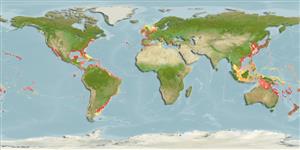Common names from other countries
Classification / Names / Names
Namen | Synonyme | Catalog of Fishes (gen., sp.) | ITIS | CoL | WoRMS
Environment: milieu / climate zone / depth range / distribution range
Ökologie
; tiefenbereich 0 - 69 m (Ref. 83939). Subtropical
Cosmopolitan.
Length at first maturity / Size / Gewicht / Alter
Maturity: Lm ? range ? - ? cm Max length : 19.0 cm TL Männchen/unbestimmt; (Ref. 402)
Life cycle and mating behavior
Geschlechtsreife | Fortpflanzung | Ablaichen | Eier | Fecundity | Larven
Members of the phylum Phoronida are mostly hermaphroditic. Life cycle: Embryos develop into free-swimming planktotrophic actinotrocha larvae which later sinks to the bottom and metamorphose into benthic adults.
Emig, C.C. and C. de Mittelwihr. 2005. (Ref. 1)
IUCN Rote Liste Status (Ref. 130435: Version 2024-1)
CITES Status (Ref. 108899)
Not Evaluated
Not Evaluated
Nutzung durch Menschen
| FishSource |
Tools
Mehr Information
Alter/Größe
Wachstum
Länge-Gewicht
Länge-Länge
Morphologie
Larven
Dichte
Internet Quellen
Estimates based on models
Preferred temperature
(Ref.
115969): 10.3 - 29, mean 25.1 (based on 2360 cells).
Verwundbarkeit
Low vulnerability (10 of 100).
Preiskategorie
Unknown.
